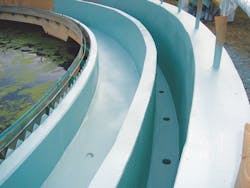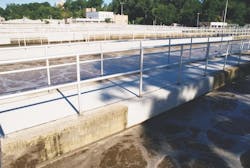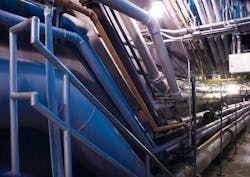About the author:
Murray Heywood is water & wastewater product development manager Eastern North America for Sherwin-Williams Protective & Marine Coatings. Heywood can be reached at [email protected].
Maintenance is a necessary evil that all wastewater facility owners and operators must address at various points in their facilities’ life cycles. Facility managers do their best to maintain optimum operating conditions to minimize maintenance needs. However, the increasingly corrosive wastewater entering sewer systems is accelerating the deterioration of concrete, steel tanks, vessels, pumps and other equipment, which increases the frequency of scheduled and emergency repairs and downtime.
The ideal method for managing wastewater facility assets is to implement a preventive maintenance plan that includes scheduled downtime for repairs, such as rehabilitating coating and lining systems that protect concrete and steel surfaces from corrosion. In a perfect world, this approach should reduce the likelihood of a facility needing an emergency repair and experiencing unscheduled downtime. Unfortunately, plant operators and managers do not work in a perfect world. Operating budgets are tight and have not kept pace with system demands, forcing operators to push facility limits and capacities, which can increase the likelihood of an emergency repair. Whether maintenance is scheduled or unscheduled, facilities operating at maximum capacity have little tolerance for shutdowns of any kind, as they impact service demands and expenses.
Standard maintenance and emergency repairs carry a high cost associated with temporary loss of the system. Shutting down a system often requires a facility to implement expensive bypass operations to divert the waste stream to other tanks or temporary holding areas until the primary system is repaired. Bypass operations can cost more than $30,000 per day for a larger plant, so every minute saved in getting the system returned to service creates significant cost savings. Fortunately, wastewater facility managers can save precious time when performing maintenance on coating and lining systems. Some newer coating technology options enable a facility to rehabilitate and repair concrete and steel surfaces and return them to service in less than 24 hours.
A Growing Need for Repairs
Over the past 50 years, many urban areas have experienced “urban sprawl” without adding new wastewater treatment facilities to manage the increased wastewater volume. While some areas have plans to build additional facilities, budget cuts from a slower-than-anticipated economic recovery have delayed or canceled construction plans. Some municipalities have found the cash to expand existing facilities, but many communities have addressed sprawl simply by adding new pipes to existing systems to carry the cargo to existing treatment plants from new subdivisions and commercial and industrial sites.
As that cargo must now travel greater distances to reach the treatment facility, this approach has caused slower waste stream flows with longer sewage dwell times in the lines. Additionally, the amount of industrial byproducts entering the waste stream has increased, creating a more eclectic mix of organics and, subsequently, a more septic waste stream. All of these factors contribute to increased corrosion rates on wastewater infrastructure.
Concrete is the typical substrate used in waste stream flows and wastewater facilities, accounting for approximately 85% of the surface areas that will require maintenance or repair. Typical concrete assets include manholes (brick, precast or poured), wet wells, lift stations, grit chambers, influent channels, primary and secondary clarifiers, and digesters. The largest contributors to the corrosion and degradation of the concrete are the increased levels of hydrogen sulfide (H2S), organic wastes (e.g. fats and grease), and industrial waste traveling through the waste stream.
Microbiologically induced corrosion (MIC) also is a major contributor to the deterioration of concrete because the microbes essential in the breakdown of the waste (Acidithiobacillus thiooxidans) ingest the H2S and excrete sulfuric acid (H2SO4). This reaction lowers the pH of the concrete and deteriorates the cement paste, leaving the aggregate exposed. Abrasion from debris and grit in the waste stream also contributes to the degradation of the concrete by eroding the surface and exposing the larger aggregate within the cement matrix.
Steel surfaces throughout a wastewater facility face similar threats as toxic waste streams and gases react with unprotected steel and accelerate corrosion.
Advancement Acceleration
In the past, the industry primarily used coal tar epoxies for severe wastewater applications to provide protection against concrete and steel corrosion. For many years, there was no viable alternative, as coal tar provided the chemical resistance needed and was reasonably easy to apply. However, there are many well-documented issues with coal tar, including its limited film-build characteristics (typically 48 to 50 mils, max), classification as a carcinogen and potential to cause burns during application. Coal tar products also experience reduced service lives in today’s more corrosive waste streams. Most significantly, coal tar epoxies can take seven to 10 days to cure before being put into service—a wait that is unacceptable given today’s maintenance challenges and budgetary constraints.
Newer fast-curing technologies have reduced return-to-service times to as little as 24 hours, depending on the size of the job and the crew. Facilities can perform surface preparation, apply repair mortar, apply a fast-curing coating material, and place a system back in service within a 24-hour period. Of course, this may not include the time to empty, clean and rinse a tank or vessel, as well as remove any existing coating or lining. This efficiency could reduce a facility’s bypass operation costs by $180,000 to $270,000.
The new coating technologies’ most intriguing component is that despite the idiom that “quick and fast means it just won’t last,” they now can deliver protection with little compromise on quality, even when curing in a fraction of the time of older technologies. This can be advantageous on construction, rehabilitation or repair projects, which are often plagued by delays and setbacks.
With rapid expansion of urban areas, wastewater facilities have matched demand with additional pipe. But with that expansion also came changes to sewage that now has longer dwell times in pipe and a more eclectic mix of organics that contribute to hydrogen sulfide gas, which is corrossive to concrete pipe.
Performing Maintenance
To perform coating and lining maintenance on concrete and steel surfaces, a plant first must shut down or bypass the systems to be repaired or rehabilitated.
A typical rehabilitation or repair of an existing concrete substrate will start with stopping any active leaks and all inflow and infiltration (I&I) issues. Contractors must properly address leaks and I&I issues, or the success of any coating system or repair will be questionable. There are many methods for stopping leaks and I&I issues, but contractors often use chemical grouting because it is both fast and permanent. Also, personnel generally can apply coatings to chemical grout products soon after application.
Next is surface preparation, which typically involves a combination of methods. First, contractors must remove the existing coating, if one exists, and clean the surface to remove any existing contamination. They can do so using high-pressure water cleaning at pressures of approximately 5,000 psi.
Hot water cleaning is the preferred method for this. Once the surface is clean, contractors can use newer methods for preparing the substrate, including wet abrasive blasting and vapor blasting. Standard dry abrasive blasting is not preferred because it creates a large amount of dust and spent abrasive that must be contained and removed by hand or vacuum truck. Vapor blasting combines small quantities of water with an abrasive media, creating less dust and often requiring no containment. Vapor blasting can be used for both concrete and steel substrates.
Following surface preparation, contractors can complete a concrete repair using some of today’s quick-return-to-service systems. For example, they may use an epoxy-reinforced cementitious repair mortar that can be top-coated in as little as eight hours. They may choose calcium aluminate repair mortars that can be top-coated in as little as 12 hours, or microsilica mortars that require 18 to 24 hours to cure prior to top-coating.
Contractors also have options for solids epoxy fillers that have a six- to 10-hour minimum recoat requirement and may make sense for certain repairs. Regardless of the coating system used, personnel must resurface the concrete as close as possible to its original plane, with all defects—such as bug holes, honeycombs, and tie wire holes—filled and fins and protrusions removed.
Once contractors complete repairs, they move on to the lining material using one of three primary technologies—epoxies (typically amine-cured), high-build aromatic polyurethanes or polyurea linings. The fast-curing capabilities of these materials depend on environmental conditions controlled using heat and/or dehumidification equipment.
All three technologies provide a high-build capability critical in wastewater applications. To decide which system is the most suitable for a given project, a facility must consider the substrate and the chemical-resistance and film-build characteristics of the technology. Epoxies provide a balanced versatility of, as they allow for application to surface saturated dry substrates, whereas polyurethanes and polyureas are averse to moisture during application.
Getting Ahead
There is no maintenance-free way to coat concrete and steel tanks for the wastewater industry. Maintenance will always be needed. Coating and lining technologies have advanced, allowing repairs to be completed in an expedited manner without compromising the integrity or service life of the system.
Owners, engineers and consultants can now confidently specify solutions knowing that they can protect an asset for years to come, while also shortening maintenance timelines to as little as a day and reducing major costs associated with system shutdowns.
SIDEBAR
Coating Advancements That Reduce Return-to-Service Timelines
The following coating and lining technology advancements from the past 10 to 15 years have enabled increasingly faster return-to-service times for water and wastewater facilities:
• High-build coatings that can be
built to 60 to 200 mils in single- or
multi-pass applications;
• Coatings that can be applied to
surface saturated dry surfaces
(i.e., surfaces that are visibly damp
with no ponding or glistening moisture
showing);
• Epoxies that can be applied on damp
(not ponding water), sweating pipes
with no dew point restrictions;
• Highly flexible coatings that bridge
small cracks on concrete surfaces;
• Quick-setting, epoxy-modified
cementitious resurfacing repair
mortars and straight resinous epoxy
resurfacers; and
• Fast-acting and fast-curing chemical
grouts that stop inflow and infiltration.


